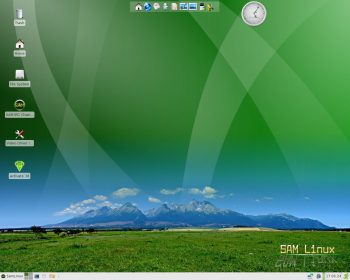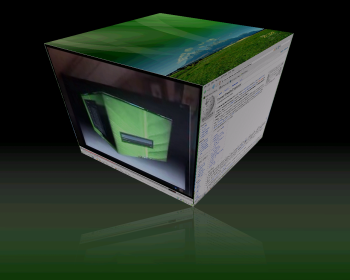Author: Preston St. Pierre
SAM Linux Desktop, an Xfce-fronted distribution based on PCLinuxOS, aims to be a complete and modern desktop operating system. Though it has problems that need to be worked out before it will match the competition, it offers an easy install, a 3-D desktop environment, and a flurry of programs to suit your needs.
The SAM install image is actually a live CD with the option to install. I was able to choose my Dvorak layout on boot by pressing F3, and SAM correctly set the layout for the system keyboard as well as the setting under X. Most distributions set one or the other, but rarely both. When SAM booted I ran the installer linked from the desktop. It was an easy, straightforward install with a few simple questions followed by about seven minutes of copying files on my Sempron 2800 with 512MB of memory. One of the things that impressed me about the installer, as small a thing as it may be, was the fact that the keyboard layout selection screen had Dvorak selected for me, reflecting my decision at boot. This is a logical consequence, but few installers take it into consideration.
When I booted to my installed system and loaded the skinned Xfce desktop, I decided to run the Install Video Driver shortcut located on the desktop. While it required manual selection of my video card (an Nvidia GeForce 7300GS), the program automatically installed the driver for me and told me to restart X. I decided to try the Activate 3D shortcut next, enabling Compiz-Fusion with full effects. However, when I restarted X and logged in, I got an error that said “‘SAM Linux Menu’ could not be loaded,” and the bottom left SAM menu did not work. There were also no 3-D effects. I tried running it again with xgl instead of native (though my card supports it). This time there was no error when I logged in, but the clock program on the desktop was not displayed, with a gray box covering the area it usually occupied. There were some 3-D effects, such as switching desktops, but it was unusably slow.
I disabled the 3-D effects and attempted to do a little troubleshooting. Turns out, the Install Video Driver program, while claiming to have successfully installed the driver, actually did nothing of the sort. xorg.conf was set to load the “vesa” driver, and when I set it to “nvidia,” thinking the script had simply not changed my configuration, X would no longer start. I went to Nvidia’s Web site, downloaded the driver for my card, and successfully installed it manually. Activating the 3-D effects was also successful at this point, though the clock was still a solid gray box.
Compiz-Fusion really is amazing. It adds some incredible visual effects without impairing usability or noticeably lagging the system. It was disappointing, however, that I had to install the driver manually after the distro’s script claimed to have installed it.
After manually installing the drivers for my card, not only did Compiz-Fusion work, but the green tinge and horrible lag I had seen when playing videos with gXine were gone. All sorts of codecs seemed to be installed, but without the video drivers the rendering was not handled well. The default audio player is Exaile, but it couldn’t handle my modest 10,000 MP3 collection without noticeable lag, especially when searching and loading the program. Luckily the Audacious audio player, a fork of Beep Media Player, which is itself a fork of XMMS, was also included.
Since I have never had problems with XMMS, I assumed Audacious would work similarly well. To my dismay, however, the scroll bar in Audacious would not work properly. I could not drag the bar up and down, making scrolling the only way to traverse the songs. As you might imagine, scrolling through that many songs is not fun. The searching at least went as quickly as I’d hoped, but the whole experience left me missing the old working XMMS.
When it comes to office programs, SAM chose to include Abiword, Gnumeric, NoteCase, Orage, and PDFedit instead of the usual OpenOffice.org. I like Abiword, and I don’t begrudge SAM for including it instead to save space, but the lack of PowerPoint support in the default SAM install led to me downloading OOo anyway. Perhaps most home desktop users won’t need to open PowerPoint presentations though, and the installed office suite covers general word processing, scheduling, and financial management areas well.
SAM includes GTKam and Xsane for your digital camera and scanning needs, as well as Inkscape and the GIMP for when you’re feeling artistic in a vector-y or bitmappy sort of way. A variety of time-wasting games are included for your playing pleasure. Streamtuner lets you browse Internet radio streams. Grip rips your music to disk, and GnomeBaker can back it up in case your disk crashes. XChat, Pidgin, and Skype are available for those who like to chat, Liferea for those who want to keep up to date via RSS feeds, and Claws Mail for staying in touch. Putty and TightVNC are included for remote connections. Firefox is the default browser, but Dillo is installed too. Wine is also included and already configured.
I ran into a few snags while using SAM, and there may be other problems I didn’t encounter. Yet even with these problems, SAM proved to be relatively easy to configure and use as a desktop system. The large variety of available programs will suit most home user needs, yet the install is kept to one CD.
SAM still has a way to go before all of the bugs get worked out, but it’s worth downloading now to take a look at.
Categories:
- SAM
- Reviews
- Linux
- Distributions




